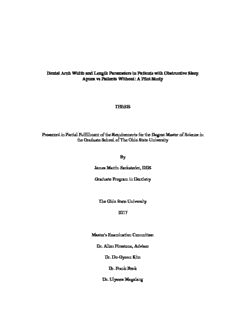Table Of ContentDental Arch Width and Length Parameters in Patients with Obstructive Sleep
Apnea vs Patients Without: A Pilot Study
THESIS
Presented in Partial Fulfillment of the Requirements for the Degree Master of Science in
the Graduate School of The Ohio State University
By
James Martin Sacksteder, DDS
Graduate Program in Dentistry
The Ohio State University
2017
Master's Examination Committee:
Dr. Allen Firestone, Advisor
Dr. Do-Gyoon Kim
Dr. Frank Beck
Dr. Ulysses Magalang
Copyright by
James Martin Sacksteder
2017
Abstract
Objective: Limited data suggests a smaller, narrow maxilla can lead to a decreased
oropharyngeal volume (OPV). However, past studies have used 2-dimensional (2D)
lateral cephalometric radiographs. The specific aim of this study is to assess how
maxillary arch parameters relate to oropharyngeal volume calculated from 3D cone beam
computed tomography (CBCT) images. An additional aim was to compare these
dimensions in a group of African-American patients with obstructive sleep apnea (OSA)
with a group of healthy controls.
Methods: 16 full head CBCT images in the closed mouth anatomic head position were
obtained from adult male African-American patients with a diagnosis of OSA. The OPV
was measured by counting corresponding voxels that are digitally isolated from the 3D
CBCT images after segmentation. The same volume axial plane images were used to
measure intercanine width, intermolar width, arch length and arch perimeter. In addition,
16 control CBCT images were obtained from adult male African-American patients
matched for age with no prior diagnosis of OSA. Each of the maxillary arch parameters
was tested for correlation to oropharyngeal volume and compared between the two
groups.
Results: Reliability was tested and for all parameters the intraclass correlation coefficient
was greater than 0.95 (0.97-1.00). The OSA group was significantly older than controls
ii
(31.9±6.9, 41.3±11.3 years respectively). After accounting for multiple comparisons the
minimum cross sectional area (MINXA) was the only parameter significantly different
between groups (p=0.0014). MINXA was found to be a good-excellent predictor of OSA
(Receiver operating characteristic curve area under curve =0.89). A cutpoint of 111mm2
was determined for MINXA between groups.
Conclusion: The CBCT based imaging analysis produces reliable measurements for all
parameters. The current finding suggest that maxillary arch width and length do not
contribute to a smaller oropharyngeal airway. MINXA is a good-excellent predictor of
OSA in African American adult males.
iii
Dedication
This document is dedicated to my loving and supportive family and friends.
iv
Vita
June 2005 .......................................................St. Wendelin High School
2009................................................................B.S. Biology, Ohio University
2014................................................................D.D.S. The Ohio State University
2014 to present ..............................................Resident and Graduate Teaching Associate,
Department of Orthodontics, The Ohio State
University
Publications
Richards MR, Fields HW, Beck FM, Firestone AR, Walther DB, Rosenstiel S, Sacksteder
JM. Contribution of malocclusion and female facial attractiveness to smile esthetics
evaluated by eye tracking. American Journal of Orthodontics and Dentofacial
Orthopedics. 2015 Apr 30;147(4):472-82.
Fields of Study
Major Field: Dentistry
Specialty: Orthodontics
v
Table of Contents
Abstract ............................................................................................................................... ii
Dedication .......................................................................................................................... iv
Vita ...................................................................................................................................... v
List of Tables .................................................................................................................... vii
List of Figures .................................................................................................................. viii
Chapters:
1. Introduction………………………………………………………………….1
2. Methods and Materials……………………………………………………….6
3. Manuscript…………………………………………………………………...10
4. Conclusions………………………………………………………………….30
Bibliography……………………………………………………………………………..37
vi
List of Tables
Table 1 Parameters to be measured ................................................................................. 17
Table 2 Reliability of Each Measurement Parameter a .................................................... 20
Table 3 Descriptive statistics for control and OSA group a ............................................. 21
Table 4 P values ............................................................................................................... 21
vii
List of Figures
Figure 1 Receiver operating characteristic curve for airway volume ............................. 23
Figure 2 Receiver operating characteristic curve for intermolar width .......................... 24
Figure 3 Receiver operating characteristic curve for minimum cross sectional area ..... 25
Figure 4 Composite receiver operating characteristic curve for AWV, IMW and
MXSAREA ......................................................................................................................... 26
viii
CHAPTER 1
INTRODUCTION
Obstructive sleep apnea (OSA) is a common disorder in which a person stops
breathing (apnea), or has a reduced air volume into the lungs (hypopnea) during sleep.
The obstruction occurs due to the collapse of the upper airway. This disorder is
increasing in prevalence as the population increases in weight, the percentage of older
individuals in the population increases, and is being diagnosed more frequently as doctors
become more aware of the disease. As of 2002 OSA syndrome (ie, an apnea-hypopnea
index (AHI) >5 with excessive daytime sleepiness) was believed to affect 2-4% of the
population1. Today we now estimate OSA affects 14% of men and 5% of women2.
Sleep apnea is associated with significant health problems, psychological and
physiological. Patients with untreated OSA are at an increased risk for stroke, diabetes,
heart failure, irregular heartbeat, myocardial infarction, and hypertension3; due not only
to lack of oxygenation, but also to increased sympathetic activity1. Psychological deficits
associated with untreated OSA include depression, anxiety, daytime sleepiness, and
increased risk of motor vehicle accidents.
There are many factors that are associated with increased risk of developing
obstructive sleep apnea. These include overweight, a large neck size (17 inches in males,
1
Description:measure intercanine width, intermolar width, arch length and arch perimeter Figure 2 Receiver operating characteristic curve for intermolar width.

